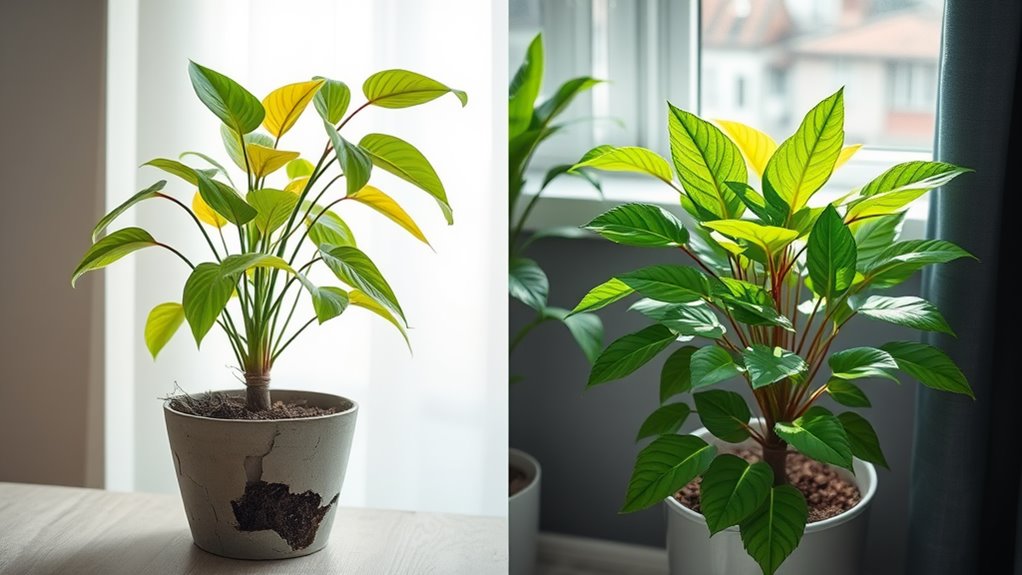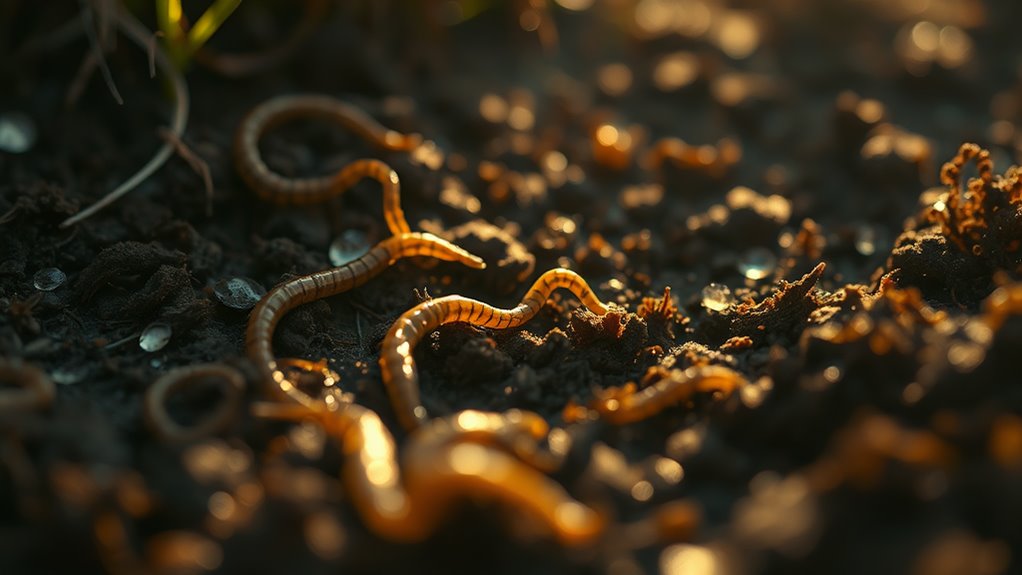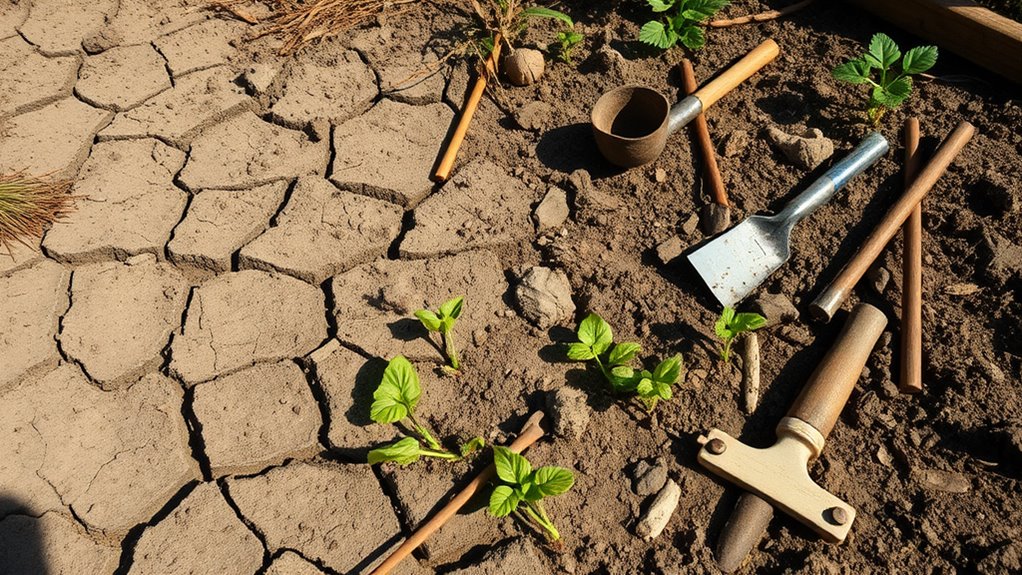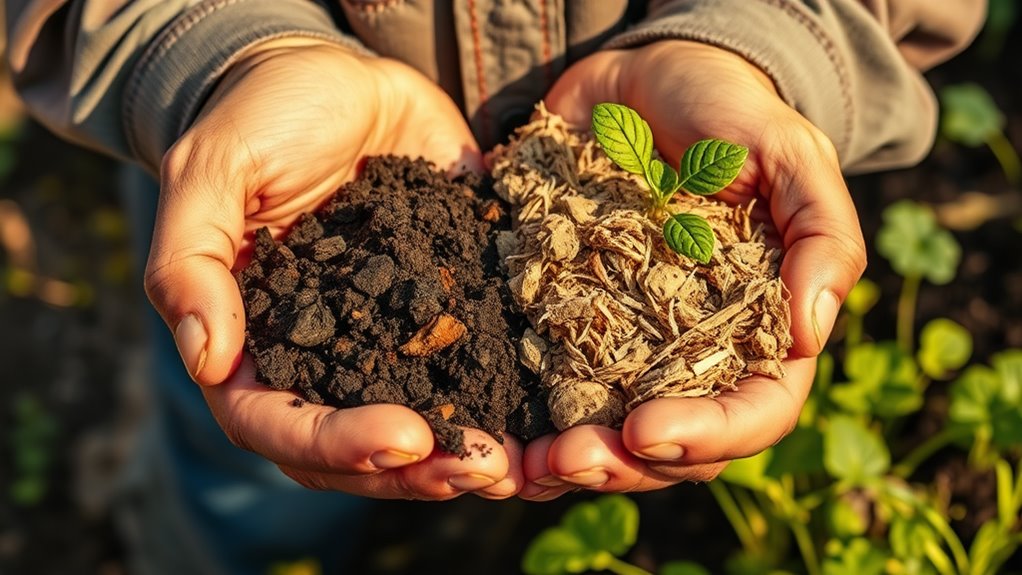Why Your Plants Keep Dying (And How to Fix It)
If your plants are dying, you’re probably overwatering them, leading to root rot and yellow leaves, or underwatering, causing wilting and brittle foliage. Check soil moisture before watering—only do it when the top inch is dry—and use pots with drainage holes to avoid soggy conditions. Test soil pH and add compost for better nutrients, while matching plants to the right light and watching for pests. Fix these issues now, and you’ll uncover even more practical tips for keeping your greens thriving.
Key Takeaways
- Overwatering drowns roots, causing rot; test soil moisture and water only when the top inch is dry.
- Underwatering causes wilting and stunted growth; water deeply when soil feels dry to revive plants.
- Poor soil quality leads to nutrient deficiencies; test pH and amend with compost for better fertility.
- Inadequate lighting stresses plants; match light needs and rotate for optimal exposure.
- Pests and diseases damage health; inspect regularly and treat with natural remedies like neem oil.
Overwatering Mistakes
One of the most common errors you’ll make with dying plants is overwatering, which drowns roots and invites rot. Overwatering tops the list of common gardening mistakes, causing root suffocation and fungal issues that weaken your plants.
You’ll notice yellowing leaves, mushy stems, or a persistent musty smell in the soil. To fix this, test soil moisture before watering—poke your finger in; if it’s wet, skip it. Additionally, if your plant is already overwatered, employ watering recovery techniques to help restore its health.
Choose well-draining pots and soil mixes, and water only when the top inch is dry. By adjusting your habits, you’ll prevent rot and restore plant vitality effectively.
Implementing these strategies will help you achieve the right watering balance to foster thriving plants.
Underwatering Symptoms
Underwatering often leaves your plants parched and struggling, showing clear signs that demand quick action.
You’ll notice wilting leaves that droop and lose their vibrancy, even in indirect light. The soil becomes bone-dry and pulls away from pot edges, while foliage turns brittle or yellows at the tips. Stunted growth or leaf drop signals severe dehydration.
Don’t overlook these cues; they’re your plant’s distress calls. Regularly check moisture levels—insert your finger into the soil to feel for dryness—and water deeply to revive them before permanent harm occurs. For long-term health, consider the deep watering technique to ensure roots receive adequate moisture.
Stay vigilant for healthier growth.
In extreme heat, implementing heat-proof watering tips can help maintain plant hydration and prevent these symptoms from worsening.
Soil Quality Problems
Poor soil quality can compound problems like underwatering by starving your plants of essential nutrients, leading to weak growth and discoloration.
To identify issues, test your soil‘s pH and nutrient levels using a simple kit; aim for a neutral range around 6-7 for most plants. If it’s too acidic, add lime; if alkaline, use sulfur.
Boost fertility by mixing in compost or organic matter, which improves drainage and structure. Avoid compaction by aerating regularly, ensuring roots access oxygen and water efficiently.
This proactive approach keeps your soil balanced, fostering robust, vibrant plants.
Moreover, soil testing before planting can enhance plant health, boost crop yields, and prevent costly gardening mistakes.
Lighting Requirements
Now that you’ve addressed soil issues, turn your attention to your plant’s lighting requirements.
You must match the light intensity to your plant’s specific needs to prevent stress and promote health.
Don’t overlook the importance of providing the correct daily light hours for vigorous growth.
Light Intensity Needs
Light intensity is essential for your plants’ survival, as each species has specific needs that, when met, prevent issues like leaf scorch or stunted growth.
You’ll need to match your plant’s requirements to your space’s light levels for optimal health. Use tools like a light meter to measure intensity accurately.
-
Assess plant needs: Check if your plant thrives in low, medium, or high light based on its type.
-
Position correctly: Place sun-loving plants near bright windows, avoiding direct harsh rays.
-
Monitor intensity: Watch for signs like yellowing leaves from too much light or leggy growth from too little.
-
Adjust setups: Use sheer curtains or reflective surfaces to fine-tune light exposure.
-
Test regularly: Re-evaluate as plants grow or seasons change to maintain balance.
Daily Light Hours
While intensity plays a key role in plant health, the total hours of daily light your plants receive can make or break their growth.
Most houseplants need 6-12 hours of light, varying by type; succulents thrive with 6-8 hours, while flowering plants like orchids require 12-14.
If yours show leggy growth, they’re light-deprived; too much can scorch leaves. You can use timers for artificial lights to maintain consistent hours, especially in winter.
Monitor seasonal changes and rotate plants for even exposure. Always check specific needs on labels or online to ensure optimal vitality and prevent decline.
Pest and Disease Issues
Pests and diseases often strike your plants, turning vibrant leaves into wilted or spotted messes if you don’t catch them early. Regular checks and quick action can save your greenery from devastation. Identify problems by examining leaves, stems, and soil for signs of trouble.
-
Spot pests like aphids or spider mites early by looking for sticky residue or webbing, then remove them with a strong water spray.
-
Prevent fungal diseases by ensuring good air circulation and avoiding overhead watering to keep foliage dry.
-
Use natural remedies****, such as neem oil, to treat infestations without harsh chemicals.
-
Isolate sick plants immediately to stop the spread to healthy ones in your collection.
-
Monitor regularly with a magnifying glass for tiny invaders, making plant care a proactive habit.
Incorporate easily accessible staples to naturally keep garden pests at bay.
To enhance your pest management, consider implementing natural pest control strategies that promote a healthy garden ecosystem.
Fertilization Errors
Fertilization errors can quickly damage your plants, much like unchecked pests. You might over-fertilize, burning roots with excess salts, or under-fertilize, starving them of nutrients.
Always test your soil first to check pH and nutrient levels before applying anything. Choose the right fertilizer—balanced NPK ratios suit most plants—and follow package instructions precisely. Additionally, incorporating sustainable practices can promote a thriving garden ecosystem by using natural methods.
Water thoroughly after feeding to prevent buildup. Monitor your plants for yellowing leaves or stunted growth; adjust your routine promptly. For a safer and more natural approach, consider using an organic fertilizer recipe made from easily accessible ingredients to nourish your plants effectively.
Temperature Fluctuations
Temperature fluctuations can wreak havoc on your plants, causing stress that leads to wilting, leaf drop, or even root damage. You must stabilize your environment to prevent these issues, as sudden changes disrupt growth and health. Additionally, incorporating DIY watering hacks can help maintain consistent soil moisture to better withstand temperature variations.
To enhance plant health, focus on optimizing plant hydration through careful watering practices that address common gardening mistakes.
-
Monitor temperatures daily: Use a thermometer to track highs and lows, ensuring they stay within your plant’s ideal range.
-
Relocate sensitive plants: Move them away from windows, vents, or doors that cause drafts or direct heat.
-
Employ protective covers: Drape frost cloths over plants during cold snaps or use shade cloths in extreme heat.
-
Choose resilient varieties: Select species adapted to your local climate to minimize vulnerability.
-
Adjust watering routines: Water less during temperature swings to avoid root rot from inconsistent soil moisture.
Pruning Oversights
Pruning oversights can quickly turn a healthy plant into a struggling one, especially if you’re not timing your cuts correctly or removing too much growth at once.
You must prune during dormant periods to minimize stress and promote recovery. For instance, avoid heavy cuts in summer when plants are actively growing, as this invites disease.
Limit removals to no more than one-third of the plant’s mass per session to prevent shock. Always inspect for dead or diseased branches first, using sharp tools for precise cuts.
This approach boosts airflow and light exposure, fostering robust growth. Remember, correct pruning enhances vitality, not harm.
By incorporating expert insights, you can achieve thriving gardens with optimized plant health and beautiful blooms.
Container Selection Errors
Choosing the wrong container is one of the most common mistakes you’ll make with your plants, potentially leading to root rot, poor drainage, or stunted growth.
To fix this, focus on containers that promote healthy roots and proper moisture control.
-
Size it right: Choose a pot that fits your plant’s roots snugly—too small crowds them, too large invites excess water.
-
Demand drainage: Always pick containers with holes to let water escape, preventing soggy soil.
-
Material matters: Go for breathable options like terracotta over non-porous plastic to regulate moisture.
-
Match the plant: Select based on needs—deeper pots for root vegetables, shallower for succulents.
-
Inspect regularly: Check for cracks or wear, and repot when roots outgrow the space.





